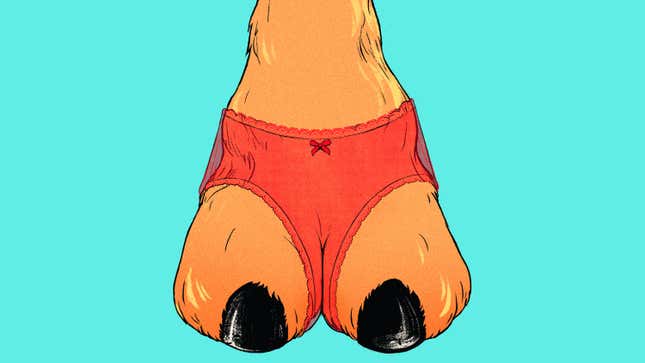A Brief History of Cameltoe
Where does the crotch discourse currently stand, and how did we get here?
In Depth
Illustration: Angelica Alzona
Several weeks ago, having embraced the excuse to swear off zippers and buttons for the foreseeable future, I bought a few pairs of discounted yoga pants. When they arrived, I excitedly ripped off the tags and tried them on, only to discover an inexplicably dramatic crotch seam that divides as the thin, clinging fabric simultaneously unites. “Holy cameltoe,” I said to the mirror. These pants seemed structurally engineered to maximize the front-wedgie effect, like a pushup bra for the crotch. I took my predicament to Jezebel Slack, genuinely wondering whether cameltoe had moved from faux pas to fashion without my knowledge. One of my editors helpfully informed me, “Tracy, you need leggings with a crotch gusset sewn in.” Turns out I’d just bought some poorly constructed yoga pants.
However, now I was thinking about the use of the term cameltoe as a peculiar cultural phenomenon that has fluxed for decades between critique, comedy, eroticization, and self-help. Now I was asking a very important question: Where does the crotch discourse currently stand, and how did we get here?
The term, already in circulation by the ‘90s, was more widely popularized in 2001 by the “Camel Toe Annie” skit on Late Night with Conan O’Brien, in which a woman wearing spandex pranced around with an over-the-top crotch bulge. Soon after, in 2002, “Cameltoe” appeared in ye old Urban Dictionary with a definition reading, “crotch cleavage, esp. on a woman. The outer lips of female genitalia visible through tight clothing.” The usage example is helpfully given by a user named Bungalow Bill: “Did you see that girl in spandex? She had serious camel-toe going on.” The following year, the hit single “Cameltoe” was released by the hip-hop group FannyPack, which was fronted by a trio of young women from Brooklyn. Their producers reportedly helped write lyrics by asking the girls, two of whom were still in high school, about the slang they used, according to the New York Times.
The song’s key lyrics: “Walking down the street/Something caught my eye/A growing epidemic that really ain’t fly/A middle-aged lady/I gotta be blunt/Her spandex biker shorts were creepin’ up the front/I could see her uterus, her pants were too tight.” An accompanying music video featured an animation of said middle-aged lady walking down the street in a crop top and spandex as her belly jiggled. Cartoon onlookers gawked, cried, and vomited in response. The Times delicately explained to readers: “Cameltoe is slang for a fashion faux pas caused by women wearing snug pants… The song is a cautionary tale, intended to help victims—help them, that is, by ridiculing them—into recovery.” The fashion misstep wasn’t spandex, so much as spandex worn by a middle-aged woman.
-

-

-

-

-

-

-

-

-

-

-

-

-

-

-

-

-

-

-

-

-

-

-

-

-

-

-

-

-

-

-

-

-

-

-

-

-

-

-

-








































